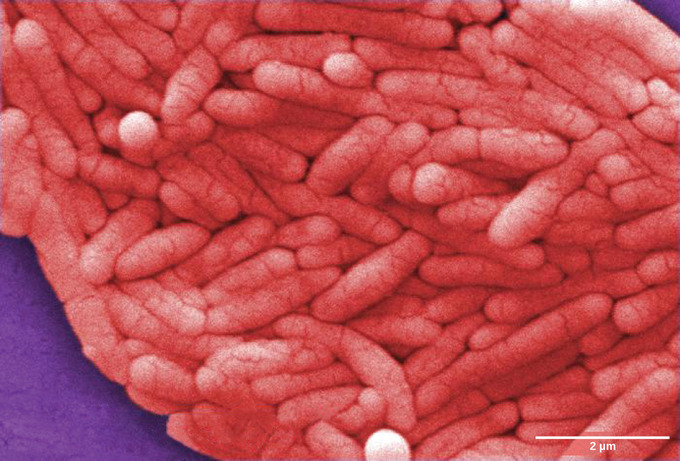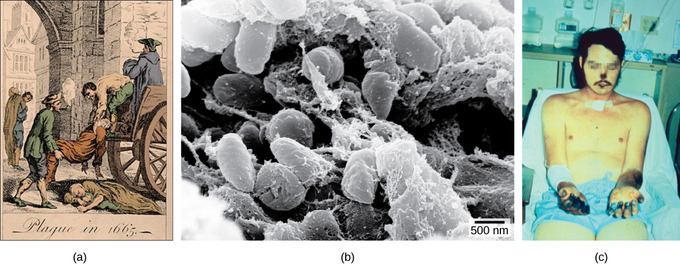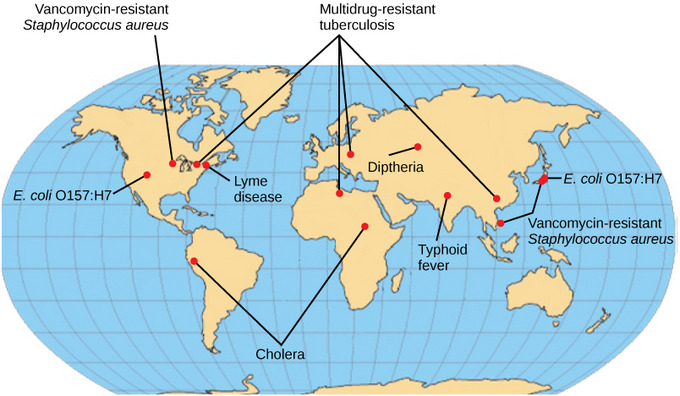22.4A: History of Bacterial Diseases
- Page ID
- 13567
- Give examples of historical, new, and re-emerging bacterial diseases in humans
There are records about infectious diseases as far back as 3000 B.C.E. A number of significant pandemics caused by bacteria have been documented over several hundred years. Some of the most memorable pandemics led to the decline of cities and nations. In the 21st century, infectious diseases remain among the leading causes of death worldwide, despite advances made in medical research and treatments in recent decades. A disease spreads when the pathogen that causes it is passed from one person to another. For a pathogen to cause disease, it must be able to reproduce in the host’s body and damage the host in some way.
The Plague of Athens
In 430 B.C.E., the Plague of Athens killed one-quarter of the Athenian troops that were fighting in the great Peloponnesian War and weakened Athens’ dominance and power. The plague impacted people living in overcrowded Athens as well as troops aboard ships that had to return to Athens. The source of the plague may have been identified recently when researchers from the University of Athens were able to use DNA from teeth recovered from a mass grave. The scientists identified nucleotide sequences from a pathogenic bacterium, Salmonella enterica serovar typhi, which causes typhoid fever. This disease is commonly seen in overcrowded areas and has caused epidemics throughout recorded history.

Bubonic Plagues
From 541 to 750 C.E.., an outbreak of what was likely a bubonic plague (the Plague of Justinian), eliminated one-quarter to one-half of the human population in the eastern Mediterranean region. The population in Europe dropped by 50 percent during this outbreak. The bubonic plague would strike Europe more than once.
One of the most devastating pandemics was the Black Death (1346 to 1361) that is believed to have been another outbreak of bubonic plague caused by the bacterium Yersinia pestis. It is thought to have originated initially in China and spread along the Silk Road, a network of land and sea trade routes, to the Mediterranean region and Europe, carried by rat fleas living on black rats that were always present on ships. The Black Death reduced the world’s population from an estimated 450 million to about 350 to 375 million. Bubonic plague struck London hard again in the mid-1600s. In modern times, approximately 1,000 to 3,000 cases of plague arise globally each year. Although contracting bubonic plague before antibiotics meant almost certain death, the bacterium responds to several types of modern antibiotics; mortality rates from plague are now very low.

Migration of Diseases to New Populations
Over the centuries, Europeans tended to develop genetic immunity to endemic infectious diseases, but when European conquerors reached the western hemisphere, they brought with them disease-causing bacteria and viruses, which triggered epidemics that completely devastated populations of Native Americans who had no natural resistance to many European diseases. It has been estimated that up to 90 percent of Native Americans died from infectious diseases after the arrival of Europeans, making conquest of the New World a foregone conclusion.
Emerging and Re-emerging Diseases
The distribution of a particular disease is dynamic. Therefore, changes in the environment, the pathogen, or the host population can dramatically impact the spread of a disease. According to the World Health Organization (WHO), an emerging disease is one that has appeared in a population for the first time, or that may have existed previously, but is rapidly increasing in incidence or geographic range. This definition also includes re-emerging diseases that were previously under control. Approximately 75 percent of recently-emerging infectious diseases affecting humans are zoonotic diseases. Zoonoses, diseases that primarily infect animals and are transmitted to humans, are of both viral and bacterial origins. Brucellosis is an example of a prokaryotic zoonosis that is re-emerging in some regions. Necrotizing fasciitis (commonly known as flesh-eating bacteria) has been increasing in virulence for the last 80 years, for unknown reasons.

Some of the currently-emerging diseases are not actually new, but are diseases that were catastrophic in the past. They devastated populations, became dormant for a while, but have re-emerged, sometimes more virulent than before. Such was the case with bubonic plague. Other diseases, like tuberculosis, were never eradicated, but were under control in some regions of the world until re-emerging, mostly in urban centers with high concentrations of immunocompromised people. The WHO has identified certain diseases whose worldwide re-emergence should be monitored. Among these are two viral diseases (dengue fever and yellow fever) and three bacterial diseases (diphtheria, cholera, and bubonic plague). The war against infectious diseases has no foreseeable end.
Key Points
- A pathogen must be able to reproduce in the host’s body and damage the host in some way to cause disease.
- Before antibiotics, contracting plagues usually meant death; however, most bacterium associated with these plagues respond to modern antibiotics; mortality rates from these diseases are now very low.
- Emerging diseases include those that have appeared in a population for the first time or that may have existed previously, but are rapidly spreading; this also includes re-emerging diseases that were previously under control.
- The spread of disease can be impacted dramatically by changes in the environment, the pathogen, or the host population.
Key Terms
- zoonosis: an animal disease that can be transmitted to humans
- plague: an epidemic or pandemic caused by any pestilence
- pathogen: any organism or substance, especially a microorganism, capable of causing disease, such as bacteria, viruses, protozoa, or fungi


